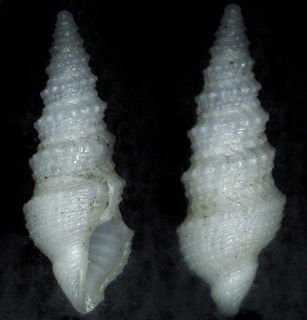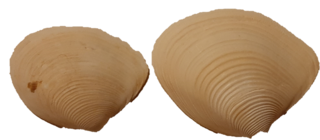Lumbriculus genitosetosus was described by Holmquist in 1976 from almost 2,000 individuals collected in Northern Alaska. Initially, Holmquist revived the genus Thinodrilus for L. genitosetosus, Lumbriculus inconstans and Lumbriculus ambiguus on the basis of the Lumbriculus-species having only one pair of vas deferens and sperm funnels per atrium, whereas the Thinodrilus-species have two ; this division is, however, not generally recognised today, even if Thinodrilus may be a valid subgenus.

Mactra is a large genus of medium-sized marine bivalve mollusks or clams, commonly known as trough shells or duck clams. Mactra is the type genus within the family Mactridae.

The brook stickleback is a small freshwater fish that is distributed across the US and Canada. It grows to a length of about 2 inches. It occupies the northern part of the eastern United States, as well as the southern half of Canada. Small populations are scattered throughout the Mississippi-Great Lakes basin extending to Colorado, New Mexico, Kentucky, Tennessee, etc., though some of these areas are not native to the species. This small fish inhabits clear, cool streams and lakes. They eat small invertebrates, algae, insect larvae, and occasionally their own eggs. They are also preyed upon by smallmouth bass and northern pike. Feeding time is usually dawn and sunset. The brook stickleback does have active competition mostly from minnows, but feeding times are different, along with diet. Spawning occurs in midsummer. Males secure a territory, build a nest, and mate with females. Males provide protection for the eggs, ward off predators, and usually die later in the season. This is considered an annual species. The nests are built out of aquatic grasses. Though the brook stickleback is not considered a threatened species, deforesting and changing waters are altering ecosystems of the species. Harvesting of trees around riparian environments is having a large effect of the stream ecosystem where the brook stickleback resides.
Conus inconstans is a species of sea snail, a marine gastropod mollusk in the family Conidae, the cone snails and their allies.

Paradrillia inconstans is a species of sea snail, a marine gastropod mollusk in the family Horaiclavidae, the turrids.
Clavatula asamusiensis is a species of sea snail, a marine gastropod mollusk in the family Clavatulidae.

Hastula inconstans is a species of sea snail, a marine gastropod mollusc in the family Terebridae, the auger snails.

Paradrillia is a genus of sea snails, marine gastropod mollusks in the family Horaiclavidae.

Anatina is a genus of saltwater clams, marine bivalve molluscs in the family Mactridae.

Thalassocalyce is a genus of ctenophore, or comb jellies, known from the California Coast, Gulf of Mexico, and west north Atlantic. It is represented by a single species, Thalassocalyce inconstans, which is the only species in the family Thalassocalycidae and the order Thalassocalycida. T. inconstans is a pelagic ctenophore typically occurring in upper-mesopelagic depths, but has been observed at depths up to 3,500 m in Monterey Canyon.
Dendronotus dalli is a species of sea slug, a dendronotid nudibranch, a shell-less marine gastropod mollusc in the family Dendronotidae.
Zenocolaspis is a genus of leaf beetles in the subfamily Eumolpinae. It is known from North America and South America. There are at least two described species in Zenocolaspis. The genus is very similar to Colaspis, but the body is smaller and the eyes are strongly convex and prominent externally.
Panula inconstans is a species of moth in the family Erebidae. It is found in North America.
Madarellus inconstans is a species of flower weevil in the beetle family Curculionidae. It is found in North America.
Pedicia inconstans is a species of hairy-eyed crane fly in the family Pediciidae.
Aneurus inconstans is a species of flat bug in the family Aradidae. It is found in North America.
Stenoptochus inconstans is a species of broad-nosed weevil in the beetle family Curculionidae. It is found in North America.
Eutrepsia inconstans is a species of geometrid moth in the family Geometridae. It is found in Central America and North America.
Abietinaria is a genus of hydrozoans belonging to the family Sertulariidae.






